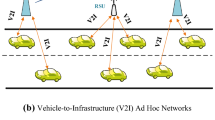Abstract
Dynamic topology and unstable wireless links make efficient data delivery in vehicular ad-hoc networks (VANETs) a challenging issue. To tackle this issue, several routing strategies for finding a route with high reliability and low latency in VANETs have been proposed. One of theme is Opportunistic routing (OR) paradigm which can improve the reliability of routing in vehicular ad-hoc networks (VANETs) by broadcasting transmission features and employing additional backup links from other neighboring nodes. In this paradigm a node sends the packet to a number of its neighbors called forwarding set. The way transmission priority is assigned to the nodes in the forwarding set can highly affect the performance of opportunistic routing. In this Paper a new measure composed of three parameters is proposed for selecting the best forwarding node. Simulations on highway environment indicate that the proposed method improves the routing performance in all grounds of QoS compared to the other published methods in the literature.












Similar content being viewed by others
References
Li, F., & Wang, W. (2007). Routing in vehicular ad hoc networks: A survey. Vehicular Technology Magazine, 2, 12–22.
Kumar, Neeraj, & Dave, Mayank. (2016). BIIR: A beacon information independent VANET routing algorithm with low broadcast overhead. Wireless Personal Communications, 87, 869–895.
Rak, J. (2013). Providing differentia levels of service availability in VANET communications. IEEE Communication Letter, 17, 1380–1383.
Saleet, H., Langar, R., Naik, K., & Boutaba, R. (2011). Intersection-based geographical routing protocol for VANETs: A proposal and analysis. IEEE Vehicular Technology Transactions, 60, 4560–4574.
Reina, D. G., Toral, S. L., Johanson, P., & Barrero, F. (2015). A survey on probabilistic broadcast schemes for wireless ad hoc networks. Ad Hoc Networks, 25, 263–292.
Chakchouk, N. (2015). A Survey on Opportunistic Routing in Wireless Communication Networks. IEEE Communications Surveys and Tutorials, 17, 2214–2241.
Thorat, S. A., & Kulkarni, P. J. (2015). Opportunistic routing in presence of selfish nodes in MANET. Wireless Personal Communication, 82, 689–708.
Laufer, R., Dubois-Ferriere, H., & Kleinrock, L. (2012). Polynomial-time algorithms for multirate anypath routing in wireless multihop networks. IEEE/ACM Transactions on Networking, 20, 742–755.
Qureshi, K. N., AbdulAltameem, A. H., & Altameem, A. (2016). Road aware geographical routing protocol coupled with distance, direction and traffic density metrics for urban vehicular ad hoc networks. Wireless Personal Communication, 92, 1–20.
Rak, J. (2014). LLA: A new anypath routing scheme providing long path lifetime in VANETs. IEEE Communications Letters, 18, 281–284.
Biswas, S., & Morris, R. (2005). ExOR: Opportunistic multi-hop routing for wireless networks. ACM SIGCOMM Computer Communication Review, 35, 133–144.
Sadeghi, B. Kanodia, V., Sabharwal, A., & Knightly, E. (2002). Opportunistic media access for multi rate ad hoc networks. In ACM in proceedings of the 8th annual international conference on mobile computing and networking (pp. 24–35).
Shin, W. Y., Chung, S. Y., & Lee, Y. H. (2013). Parallel opportunistic routing in wireless networks. IEEE Transactions on Information Theory, 59, 6290–6300.
Liu, C., & Wu, J. (2013). On multicopy opportunistic forwarding protocols in nondeterministic delay tolerant networks. IEEE Transactions on Parallel and Distributed Systems, 23, 1121–1128.
Rosario, D., Zhao, Z., Braun, T., Cerqueira, E., Santos, A., & Li, Z. (2013). Assessment of a robust opportunistic routing for video transmission in dynamic topologies. IEEE in Wireless Days (WD), 2013, 1–6.
Leontiadis, I., & Mascolo, C. (2007). Geopps: Geographical opportunistic routing for vehicular networks. In IEEE international symposium on a world of wireless, mobile and multimedia networks (pp. 1–6).
Yu, D., Ikram, M., & Ko, Y. B. (2009). (VVOF) velocity vector-based opportunistic forwarding in vehicular sensor network. Communications and Information Technology, ISCIT, 2009, 627–628.
Ting, Y., Li, Y., Ma, X., Shang, W., Sanadidi, M. Y., & Gerla, M. Y. (2013). Scalable opportunistic VANET content routing with encounter information. In 21st IEEE international conference on network protocols (ICNP), IEEE (pp. 1–6).
Cai, X., He, Y., Zhao, C., Zhu, L., & Li, C. (2014). LSGO: Link state aware geographic opportunistic routing protocol for VANETs. EURASIP Journal on Wireless Communications and Networking, 2014, 1–10.
Rehman, O., Ould-Khaoua, M., & Bourdoucen, H. (2016). An adaptive relay nodes selection scheme for multi-hop broadcast in VANETs. Computer Communications, 87, 76–90.
Cheng, L., Henty, B. E., Stancil, D. D., Bai, F., & Mudalige, P. (2007). Mobile vehicle-to-vehicle narrow-band channel measurement and characterization of the 5.9 GHz dedicated short range communication (DSRC) frequency band. IEEE Journal on Selected Areas in Communications, 25, 1501–1516.
Celimuge, C. W., & Ohzahata, S. (2012). VANET broadcast protocol based on fuzzy logic and lightweight retransmission mechanism. IEICE Transaction on Communication, 95, 415–425.
Couto, D., Bicket, J., & Morris, R. (2005). A high-throughput path metric for multi-hop wireless routing. Wireless Networks, 11, 419–434.
The Network Simulator—ns-2, The Network Simulator—ns-2. http://www.isiedu/nsnam/ns/. Accessed 23 May 2013.
Enkelmann, W. (2003). Fleet-net-applications for inter-vehicle communication. In IEEE proceedings intelligent vehicles symposium (pp. 162–167).
Charash, U. (1979). Reception through Nakagami fading multipath channels with random delays. IEEE Transactions on Communications, 27, 657–670.
Author information
Authors and Affiliations
Corresponding author
Rights and permissions
About this article
Cite this article
Naderi, M., Zargari, F., Sadatpour, V. et al. A 3-Parameter Routing Cost Function for Improving Opportunistic Routing Performance in VANETs. Wireless Pers Commun 97, 109–123 (2017). https://doi.org/10.1007/s11277-017-4496-5
Published:
Issue Date:
DOI: https://doi.org/10.1007/s11277-017-4496-5




